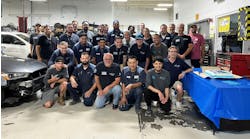A Lesson In Economics
CHICAGO (Oct. 18, 2005) - In an industry of continual technological evolution and a world of increasing supply-side competition, of depleting resources and shifts in consumer demand, the brewing of a perfect storm's ingredients is evident.
Change is a constant. But how one perceives and reacts to it varies. For the aftermarket - whether making and distributing parts thru the supply chain or servicing and repairing vehicles in shop bays - lessons and wisdom can be harvested from watching automakers deal with dynamic forces within the industry. For in their current market situation, there is much to consider regarding the automotive aftermarket's future.
Moving forward while looking back Identifying the sweet spot of the market is no easy task. It's that zone of high demand and sustainable profits. Unfortunately, it's more recognizable looking back than it is to anticipate moving forward. That's the rub. It's the bulls-eye everyone chases. From automaker to shop, success in the quest to be aligned and in sync with market shifts - by having the right products at the right time at the right cost - is like finding the Holy Grail. Conversely, finding oneself positioned anywhere else can be devastating to bottom lines and, should it happen too often, long-term futures.Clayton M. Christensen of the Harvard Business School is an author and professor in the field of technological innovation and disruption within industries. Whether on the cutting edge or trailing edge of innovation, there's consequences for both action and inaction for the incumbent heavyweights and the smaller or startup companies. Recognizing the changing market demographics and innovative forces is one thing. Doing something in time, on-time - taking informed, timely risk to embrace the right innovations - is quite another, he says.
The technologywas OK for
golf carts perhaps,
but not mainstream American commuters.
Too quick: One gets to market but has to wait for consumer demand to arrive, says Christensen. Having the capital reserves to weather that can be expensive. The waiting can simply force some, especially smaller companies, out of the industry or into being assimilated by a larger incumbent. Too slow, he adds, and latecomers yield traction and presence in a new market to others, ground that may never be recovered. In addition, continued slow reaction to shifts in consumer demand can easily result in the leadership transfer from incumbent veterans to others. The trick, Christensen contends, is finding a sustaining balance in recognizing innovations worth adopting in time.
Hybrids: Innovation or disruption? Hybrid vehicle technology has been around for a century. Back then, perhaps the case for it being a technological disruption could be made, says Christensen. It was new. It contradicted the thinking and technology of that time, and the demand for such a product and economic pressures on consumers were too low to motivate market demand shifts. Gasoline was relatively cheap, so why bother?Likewise the efficiencies and environmental impact of electric drives isn't new, nor exclusive to just the automotive industry. Electric motors driving machinery has been commonplace for years. A regular and convenient source of power was key to the usage. With automobiles, the earlier introduction of electric vehicles came with inconveniences. A consumer had to regularly plug them in at night, while battery capacity, range and performance left much to be desired. The technology was OK for golf carts perhaps, but not mainstream American commuters.
Yet the notion of using electricity to power mobility didn't die, says Christensen. The innovative marriage of electric drive with internal combustion engine technologies ensued, leading to current hybrid concepts in use and on drawing boards today. As well, forces outside the industry brought timing to the forefront - petroleum depletion, rising prices, environmental concerns and geopolitical pressures.
In or outside the box? For some time, the sweet spot for automobiles has been in the SUV market, an area where domestic automakers have had the edge over imports. Yet for a number of years, studies by firms such as Maritz Research into how recent rises in gasoline prices and long-term projections of higher prices in the future are combining to drive demand towards fuel-efficient hybrid vehicles were seen as indicators of opportunity knocking by some, while being ignored or discounted by others. Toyota, by many accounts, is the gorilla in the current hybrid market with a line of hybrid vehicles today that overwhelms most other automakers.Like many innovations, Christensen suggests that the ability to see and think and move in ways that are outside the box separates success from wishful thinking. As well, rigid and limited focus can obscure the ability of OEMs to see future opportunity and direction. Like test-driving through a course of orange cones and curves, looking too close at the corner, as opposed to where you're heading on the other side leads to less than desired results.
The current woes faced by some automakers, the short-term thinking of corporate America focused on quarterly reports and shareholders' reaction, and the continued, successful implementation by competitors of innovations that are consumer-driven rather than corporate-driven all conspire to act like lead weights in a pool of quicksand. Among the automakers, the divergence between those who anticipated and those who trailed the consumer demand shift resulting from rising fuel prices is clear. Inventories of current models and marketing campaigns are just some of the indicators sorting the wheat from the chaff.
Domestically, DaimlerChrysler is still hyping its HEMI performance engine and developing diesel engines. General Motors decided recently it should be in the hybrid market, and though late, has begun to move - underscoring the improved fuel economy of its SUV fleet ramping up hybrid production. Only Ford is in the hybrid game currently, with several hybrid SUVs already available. Not only that, but those Ford hybrid SUVs managed to take three of the top 10 rankings on the EPA's recently released list of the most fuel-efficient vehicles.
Yet the domestic OEMs pale when compared to some of the foreign automakers, such as Honda and Toyota. Honda not only has several hybrids established in the market, it also has a highly fuel-efficient compressed natural gas vehicle in its Civic GX. Yet despite its tremendous fuel economy, the vehicle has some of the inconvenient characteristics that earlier electric cars had, such as the need for overnight refueling and a shorter driving range.
Presence and vision There is a story about Wayne Gretzky, one of the best hockey players of all time. Compared to others in the game, he was slighter of frame, on the slower side, less physical, had a slower shot and a host of other disadvantages at a glance. But Gretzky had two assets you can't measure: He had presence, and he had vision. His presence was one of movement - always being in motion, no matter where he was on the ice or how confined the space was. And vision? Well, he was once asked the secret to his success. His response? He replied that he simply didn't go where the puck was, instead, he went to where the puck was going to be. Katsuaki Watanabe, the president of Toyota Motors saidhe has told
his engineering chief to find a way to cut
the price difference
in half between fuel-efficient gas-electric hybrids and similar
gasoline models.
Toyota, by many accounts, is the gorilla in the current hybrid market with a line of hybrid vehicles today that overwhelms most other automakers. At first glance, some may think that Toyota's dominance in the hybrid market is in part because consumer demand zigged when many others thought it would zag. But it wasn't just luck. Toyota wasn't first into the hybrid market, but today, it enjoys the sweet spot. It has traction, and isn't standing still.
Besides luck, it's also about corporate culture. Positioning enables follow through. It's about being able to read and react, not so much for an unexpected and drastic strategic shift, but rather having presence in market and mind to adapt to an acceleration in demand of what one already anticipated was a place worth being. It's the ability to envision "what if" as opposed to embracing "what's been."
Like Gretzky, Toyota displays a culture of moving presence and vision. While some other automakers are just getting into the hybrid game, Toyota is accelerating production, anticipating rising demand. It is locking in key component suppliers based on future needs not current sales. In addition, it is considering innovative marketing and disruptive competitive pricing strategies within the hybrid market to put the squeeze on the competition.
Toyota has been on a torrent of recent purchases and contractual agreements with key hybrid component suppliers: Fuji Heavy Industries for its hybrid expertise; batteries from Panasonic; and Hitachi for hybrid electric motors are just a few examples.
In addition, beyond the current trend towards hybrid vehicles, there is a coming wave of hydrogen fuel cell vehicles on the horizon. Using hydrogen to produce electricity to power vehicles, demand for diesel and gasoline combustion engines will decline. But the electric components and technology used successfully in hybrids will be transferable to fuel cell vehicles.
Catching up won't be easy The price gap between hybrids and related conventional models may not stay the same as the $3,500 to $7,500 range it is today. As the rest of the pack tries to get back in the race, research and development costs, production tooling costs, marketing and a host of other new infrastructure costs will have to be offset. Yet, if those automakers are counting on that pricing gap to provide the return on investing in hybrid production, there may be a hitch.Toyota is considering narrowing the premium between hybrid and conventional counterparts. In a recent briefing to analysts and media on Wall Street, Katsuaki Watanabe, the president of Toyota Motors said he has told his engineering chief to find a way to cut the price difference in half between fuel-efficient gas-electric hybrids and similar gasoline models.
The American International Automobile Dealers Association (AIADA), Bloomberg, USA Today and others reported that Watanabe said, "My goal is to reduce that difference to one-half the current levels, but I cannot say what the timeframe for that would be." That could mean lowering hybrid prices. It might mean raising conventional prices. It might be a combination of both. For the latecomers, just the possibility that Toyota might do something is disruptive to other OEMs, and if it comes to fruition, even more so.
Hybrids are on the road, and their numbers increase every day. That will impact the mix of vehicles being repaired, maybe sooner than one thinks. And like automakers, the rest of the industry has some decisions to contemplate: Choose to stand pat or innovate. Continue to focus on where the market is, or has been, rather than where it's headed.
Is this the time to be one of the crowd or is it the time to differentiate via planning, performance, branding and service by combining a moving presence with outstanding vision? The winds of change are at hand.
(Sources: Maritz Research, EPA, Harvard Business School, Toyota, AIADA)

